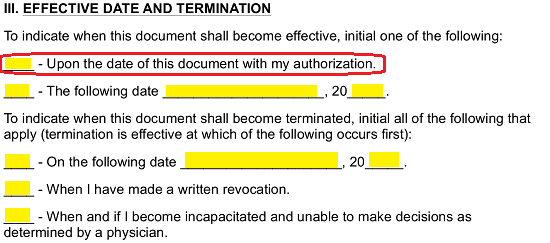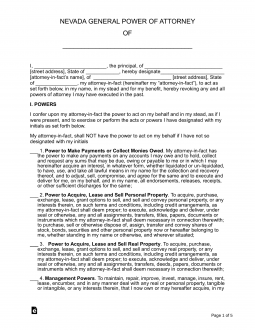Updated August 09, 2023
A Nevada general (financial) power of attorney form is a document used to appoint an agent to act on your behalf in financial matters. Your agent will be able to transact business in your name with your property and assets. Therefore it is imperative that your agent be someone of the utmost trustworthiness and reliability – someone you know who desires to act in your best interest. How is this different from the durable form? Both forms convey general financial authority to another, but this form becomes void at the time you no longer can make your own decisions as determined by a physician. If you are looking to plan for incapacity, you may want to use the durable form instead.
Laws
- Statutes – Power of Attorney (Uniform Act)
- Authority (N.R.S. 162A.460) – An agent under a power of attorney may act on behalf of the principal and exercise broad authority as granted by the agreement.
- Signing Requirements (N.R.S. 162A.220) – Notary Public.
How to Write
Download: PDF, MS Word, OpenDocument
1 – Supply The Title and Introduction With Identity Information
The Principal’s Full Name must appear on the blank space beneath the title.
Clearly, print the Principal’s Full Name on the first blank space in the initial paragraph.  The second blank space will require the complete Street Address where the Principal resides. When entering this information make sure you are reporting the geographical location where the Principal is physically located. You may not enter a P.O. Box as an Address. Finally, enter the State where the Principal lives on the third blank space.
The second blank space will require the complete Street Address where the Principal resides. When entering this information make sure you are reporting the geographical location where the Principal is physically located. You may not enter a P.O. Box as an Address. Finally, enter the State where the Principal lives on the third blank space.  Now that we have identified who will be granting Power, we must identify who will be entitled to wield Principal Authority over Principal Property. This entity will be referred to as the Principal’s Agent. You will need to use the next enter the Agent’s Full Name on the blank space after the words “…hereby designate.
Now that we have identified who will be granting Power, we must identify who will be entitled to wield Principal Authority over Principal Property. This entity will be referred to as the Principal’s Agent. You will need to use the next enter the Agent’s Full Name on the blank space after the words “…hereby designate.
After identifying the Agent, record his or her Physical Home Address on the blank space preceding the bracketed term “Street Address,”
Conclude the Agent report by entering his or her State of Residence on the final blank line of this paragraph.

2 – Select The Types Of Authority Being Granted To The Agent
The next several paragraphs will seek to define in what areas of the Principal’s life the Agent may utilize Principal Powers over. Each paragraph description should be reviewed by the Principal. If the Principal wishes to grant his or her Authority to the Agent in the manner described by that paragraph, then he or she should initial the corresponding blank space.
Locate the first item in Article I (“Powers”). This paragraph will solidify the Principal’s desire to grant his or her Agent to perform the action of making or collecting Payments on behalf of the Principal if the Principal initials the blank space preceding the number “1.”
The Principal may then turn his or her attention to the second item, “Power To Acquire, Lease, and Sell Personal Property.” If the Principal initials this paragraph description the Agent will be able to carry out all the actions defined here (i.e. selling or conveying the Principal’s Personal Property on behalf of the Principal).
The next issue will be that of Real Property. If the Agent should have the Principal Approval to “Acquire, Lease, and Sell” the Principal’s Real Property, the Principal will need to initial the third paragraph description.
The Principal may also give Management Powers over his or her Personal and Real Property by initialing the fourth paragraph description.
The fifth paragraph description will describe the Principal Banking Powers that may be delivered to the Agent through this document.
The “Motor Vehicles” description enables the Principal to grant his or her Authority in relation to Motor Vehicles in his or her control to the Agent so long as the Principal initials the blank space preceding the number “6.”
The Agent may use Principal Authority over the Principal’s Tax Matters as described in the seventh paragraph description once the Principal’s initials have been supplied on the corresponding blank space.
The Agent can be given Principal Access and Principal Control over the Principal’s Safe Deposit Boxes as per the eighth paragraph description if the Principal provides his or her initial on the corresponding blank space.
The Principal will grant the Authority to give, receive, and negotiate Gifts on his or her behalf to the Agent by initialing the ninth paragraph description.
The tenth description shall cover the subject of “Lending and Borrowing.” The Principal can give the Agent the right to participate in Lending or Borrowing capital in the Principal’s Name by initialing the blank space just before the number “10.”
If the Principal also expects the Agent to enter, dissolve, negotiate, or generally handle Contracts on his or her behalf, the Principal will need to initial the blank space attached to the eleventh paragraph description.![]()
The twelfth paragraph description will define the manner in way the Agent may act, regarding the Principal’s Health Care. The Principal should initial the blank space preceding the number “12” to grant the Agent these Health Care Powers.
The Principal can name the Agent Representational Powers to the Agent according to the Health Insurance Portability And Accounting Act of 1996 by initialing the thirteenth paragraph description.![]()
In the fourteenth description, the Principal may grant the Agent the “Power to Hire and Pay for Services” in the Principal’s Name. If this is desired, the Principal should initial the blank space preceding this paragraph.
The Principal may grant the Agent the right to compensation if he or she has accrued any expenses while in the Principal’s service. If this should be granted to the Agent, the Principal will need to initial the fifteenth paragraph.![]()
The Agent may “Sue Third Powers Who Fail To Act Pursuant” to this document if the Principal initials the sixteenth paragraph.
The Principal may define additional Subject Matters the Agent may utilize Principal Authority over by listing them on the blank spaces supplied in the seventeenth item. If this option is taken, the Principal will also need to initial the blank space just before the number “17.”
3 – Deliver The Specifics On When The Agent May Use Principal Authority
The Principal will also need to define when the Agent will have such Power available to him or her. This will be accomplished nicely in Article III. First the Principal will need to define when these Powers become available to the Agent. The Principal may grant these Powers immediately upon this document’s execution by initialing the first statement.  If desired, the Principal may name a specific Start Date by initialing the second state then, providing the Start Date using the spaces provided. The Principal may only choose one of these first two statements.
If desired, the Principal may name a specific Start Date by initialing the second state then, providing the Start Date using the spaces provided. The Principal may only choose one of these first two statements.
Next, the Principal will need to define when the Powers delivered here should terminate. If they should terminate on a specific Date, the Principal should initial the third statement in this Article then, provide the Date of Termination in the spaces provided.  If the Principal initials the fourth statement, these Powers will remain in effect until a written Revocation is issued by the Principal.
If the Principal initials the fourth statement, these Powers will remain in effect until a written Revocation is issued by the Principal. Finally, the Principal may choose these Powers to remain in effect until he or she is incapacitated or dies by initialing the last statement. Only one of these last three statements may be selected by the Principal.
Finally, the Principal may choose these Powers to remain in effect until he or she is incapacitated or dies by initialing the last statement. Only one of these last three statements may be selected by the Principal.
4 – Finalize This Document’s Appointment Through The Principal Signature
To finalize this document, the Principal will need to execute it with a Notarized Signature. The “In Witness Whereof” statement just after the paragraph in Article IV requires he or she enter the Calendar Date, Month, and Year of Signing.
The Principal must then Sign and Print his or her Name on the blank spaces labeled “Principal’s Signature” and “Principal’s Printed Name” (respectively).
The Agent will also need to directly participate in the finalization of this document’s appointment by acknowledging and accepting the terms of Principal Power defined here. Locate the section titled “Acceptance of Appointment,” then print the Agent’s Full Name on the first blank line in the paragraph provided. Directly below this paragraph, the named Agent will need to Sign and Print his or her Name on the blank lines provided.
The next section, “Witness,” must be read by each individual who has observed the Principal Signing. Once done, each Witness must Sign his or her Name and enter his or her Address.
The final section in this document is reserved for the Notary Public. This entity will provide the information and Notary credentials require to Notarize the Principal Signing in the “Acknowledgment of Notary Public” section.


